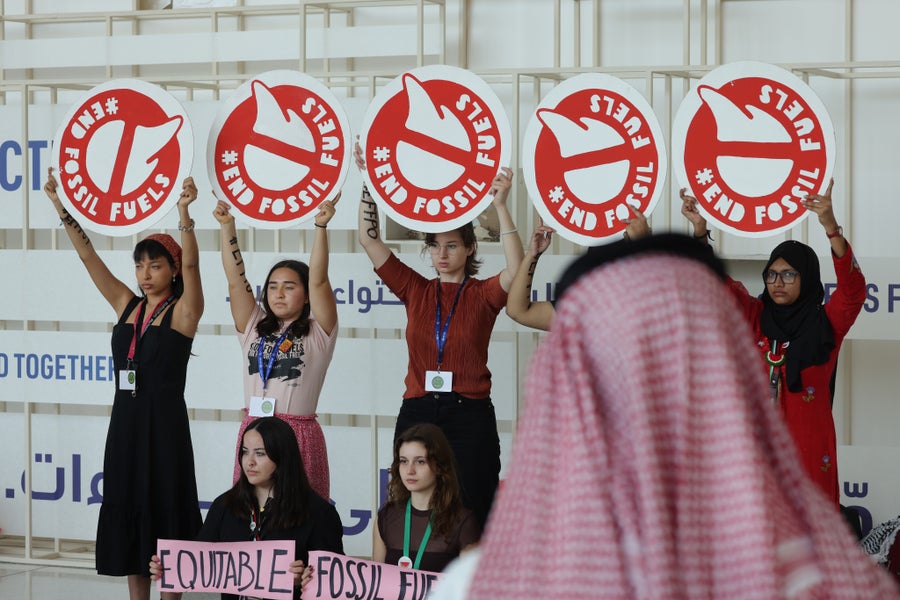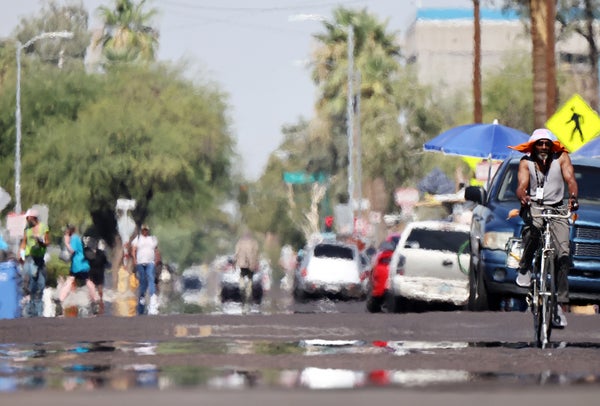To say the year in climate has been a mixed bag is an understatement. There have been glimmers of hope alongside stark reminders of the peril we all face if we don’t quickly slash greenhouse gas emissions.
Early in the year the Intergovernmental Panel on Climate Change (IPCC) released the final installment of its Sixth Assessment Report, which was, as United Nations secretary-general António Guterres put it, “a how-to guide to defuse the climate time-bomb.” As 2023 came to a close, there was some encouraging, if modest, movement forward on international and U.S. climate action. But this will also be the hottest year on record, driving home how inadequate that action has been to date.
Here, Scientific American rounds up this year’s biggest climate stories.
On supporting science journalism
If you're enjoying this article, consider supporting our award-winning journalism by subscribing. By purchasing a subscription you are helping to ensure the future of impactful stories about the discoveries and ideas shaping our world today.
“Gobsmackingly Bananas” Heat
Record-shattering extreme heat was a constant in the news this year. There were numerous record-breaking heat waves around the world, from the U.S. Southwest to Europe to China. There were even summerlike temperature during winter in South America. Researchers concluded several heat waves were made many times more likely by climate change—some would have even been “virtually impossible” without global warming. Extreme heat is particularly dangerous for the very old, the very young and low-income communities that may not have access to air-conditioning. In some places, such as Europe, punishing summer heat stretched hospital capacity to COVID-era levels.
Every month from June to November was the hottest such month on record. Even more stunning, July was the hottest month ever recorded on the planet—and likely the hottest in at least 120,000 years—by a wide margin of 0.2 degree Celsius (about 0.4 degree Fahrenheit). And September was the most anomalously warm month, measuring about 0.5 degree C (0.9 degree F) hotter than the previous hottest September in 2020. In a post on X (formerly Twitter), climate scientist Zeke Hausfather called that record “absolutely gobsmackingly bananas.”
Though a burgeoning El Niño, part of a natural climate cycle, has contributed a little heat to the planet, the exceptional global temperatures in 2023 are largely driven by the 1.2 degrees C (2.2 degrees F) of warming since preindustrial times. This year should serve as a warning of the future we face if we don’t take rapid, ambitious action to cut emissions generated by burning fossil fuels. “This is what the world looks like when it’s 1.5 degrees [C] hotter in a year, and it’s terrible,” climate scientist Kate Marvel told Scientific American.
Success or a COP-Out?
The international climate summit that convenes every year to hash out how the world will address the climate crisis is always subject to lofty goals but frequently ends with little concrete accomplishment. In November this year’s event—the 28th Conference of the Parties, or COP28—took some steps toward action to prevent warming of more than 1.5 degrees C above preindustrial levels yet still left many climate experts and environmental advocates cold.
The massive conference (with some 100,000 attendees) opened with the approval of a fund to compensate communities for unavoidable climate change—referred to as a “loss and damage” fund in U.N. parlance—something many developing countries have been advocating for years. These countries shoulder a disproportionate burden of climate change’s effects despite having contributed very little to global warming. Several countries, including COP28’s controversial host nation, the United Arab Emirates (UAE), pledged tens of millions of dollars to the fund. The U.S. pledged only $17.5 million. Though welcome, the funding is well short of what is needed—something it has in common with most other funding slated to help countries adapt to climate change and develop renewable energy sources.

Activists protest against fossil fuels on day 10 of the COP28 climate conference in Dubai on December 10, 2023. Credit: Sean Gallup/Getty Images
The nonbinding deal that emerged from the conference included historic language on “transitioning away from fossil fuels,” the first time those fuels were explicitly singled out. Previous deals discussed reducing emissions but not how those reductions should come about, which left the door open for participants to continue to burn fossil fuels and either capture the emitted carbon (a technology that is not yet fully developed to run at scale) or offset the emissions with sometimes dubious carbon credit schemes.
While the new agreement acknowledged the need to stop burning coal, oil and gas, it still sanctioned the use of those fuels during the transition to clean energy and was gaveled in before some countries who did not fully support the text could enter the room. And the language stands in contrast to the billions of dollars that countries such as the UAE, the U.S. and China have slated to develop further fossil fuel resources.
Insurance Underwater
Homeowners and businesses often pay for insurance policies so that they can be financially protected in the event of disaster, whether it’s a tornado or inundation by muck-filled floodwaters. But this year it became very clear that climate change is catching up with the insurance industry.
Climate change is exacerbating many natural hazards, from flood-causing extreme downpours to damaging thunderstorms to devastating wildfires. The onslaught of such disasters in recent years has left insurers in California, Florida and Louisiana with huge losses and several bankruptcies. Some insurance companies have said they will not sell or renew policies in California and Florida because of high risks from extreme events. Other insurers have raised their premiums, which can make the policies unaffordable for some people. This year the U.S. Department of the Treasury announced a plan to require 213 large insurers to provide information on what policies they sell and where so that the government can glean if particularly vulnerable communities are underinsured.
Without private insurance, more people will rely on public insurance programs or postdisaster funds, which don’t always have adequately robust coffers. In early 2023 Florida’s public insurer warned earlier that Hurricane Ian had “significantly depleted” its reserves, which might mean it will have to increase fees for policyholders And as of that time, a state-run plan in California had a $332-million deficit. Additionally, postdisaster funds from the Federal Emergency Management Agency are limited in scope and subject to budget battles in Congress.
Such developments in the insurance industry this year—which set a record for the number of billion-dollar disasters in the U.S.—could be a harbinger of the physical and financial risks that lie ahead.
Biden’s Ambition
In 2023 the Biden administration continued to plug away on rulemaking, executive action and international diplomacy to help reduce U.S. greenhouse gas emissions (which were projected to fall by 3 percent this year). Its efforts only mark a beginning, and they are somewhat counteracted by practices such as continuing to hold auctions for leases to develop fossil fuels. But nevertheless, they are by far the most ambitious climate actions the country has ever taken.
At the COP28 climate meeting, the Environmental Protection Agency announced its finalized rule to significantly cut methane emissions from the oil and gas industry, in part by addressing leaks in pipelines and other infrastructure. For the first time ever, such rules cover facilities built before 2015.
And the U.S.’s frosty relations with China thawed a bit, at least on the climate front, with an agreement between the world’s two largest emitters to grow renewable energy and develop carbon capture technologies.
The administration also expanded environmental justice protections and authorized the creation of an American Climate Corps, which, following in the footsteps of the New Deal–era Civilian Conservation Corps, will hire thousands of young people to work on wind and solar energy projects, make homes more energy-efficient and restore ecosystems.
The durability of this progress made under Biden will depend in large part on how the 2024 election shakes out because Republican candidates have vowed to try to undo many of his efforts. But if all goes right, the country could still meet his goal of reducing U.S. emission by half.
